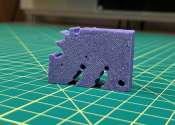Instant evolution: AI designs new robot from scratch in seconds
A team led by Northwestern University researchers has developed the first artificial intelligence (AI) to date that can intelligently design robots from scratch.
Oct 2, 2023
2
296
Robotics

A team led by Northwestern University researchers has developed the first artificial intelligence (AI) to date that can intelligently design robots from scratch.
Oct 2, 2023
2
296
Engineering

"For the first time ever, we have direct experimental evidence that an external quantum efficiency above 100% is possible in a single photodiode without any external antireflection," says Hele Savin, associate professor of ...
Energy & Green Tech

It looks like a regular roof, but the top of the Packard Electrical Engineering Building at Stanford University has been the setting of many milestones in the development of an innovative cooling technology that could someday ...
Sep 5, 2017
2
2238
Engineering

A research team led by scientists from the City University of Hong Kong (CityU) has recently developed a droplet-based electricity generator (DEG) with a field-effect transistor (FET)-like structure that allows for high energy ...
Feb 5, 2020
5
5967
Engineering

Scientists have found that concrete's compressive strength can be increased by 4.1% and its flexural strength by 3.4% by adding a small amount of coconut shell (only 5%). The material's performance increased by 6.1% compared ...
Oct 10, 2023
0
151
Engineering

As important as the internal combustion engine has been for societal progress, it is also a major contributor to pollution that damages human health and carbon emissions that help drive the climate crisis. Close to 30% of ...
Aug 16, 2022
0
262
Robotics

Insect-size robots could have numerous useful applications, for instance, aiding search and rescue (SAR) missions, simplifying the inspection of infrastructures and speeding up agricultural processes. Despite the advantages ...
Engineering

Wearable sensors are evolving from watches and electrodes to bendable devices that provide far more precise biometric measurements and comfort for users. Now, an international team of researchers has taken the evolution one ...
Oct 9, 2020
0
300
Robotics

Chinese electronics company Xiaomi has unveiled CyberDog, a quadruped robot that the company describes as more personable than others in its class. The company made its announcement on its Twitter feed, calling it a "true ...
Robotics

A trio of researchers at Korea Advanced Institute of Science and Technology, working with a colleague at the University of Illinois at Urbana-Champaign, has designed and built a working quadruped robot with magnetized feet ...
In mathematics, specifically in topology, a surface is a two-dimensional topological manifold. The most familiar examples are those that arise as the boundaries of solid objects in ordinary three-dimensional Euclidean space R3 — for example, the surface of a ball or bagel. On the other hand, there are surfaces which cannot be embedded in three-dimensional Euclidean space without introducing singularities or intersecting itself — these are the unorientable surfaces.
To say that a surface is "two-dimensional" means that, about each point, there is a coordinate patch on which a two-dimensional coordinate system is defined. For example, the surface of the Earth is (ideally) a two-dimensional sphere, and latitude and longitude provide coordinates on it — except at the International Date Line and the poles, where longitude is undefined. This example illustrates that not all surfaces admits a single coordinate patch. In general, multiple coordinate patches are needed to cover a surface.
Surfaces find application in physics, engineering, computer graphics, and many other disciplines, primarily when they represent the surfaces of physical objects. For example, in analyzing the aerodynamic properties of an airplane, the central consideration is the flow of air along its surface.
This text uses material from Wikipedia, licensed under CC BY-SA